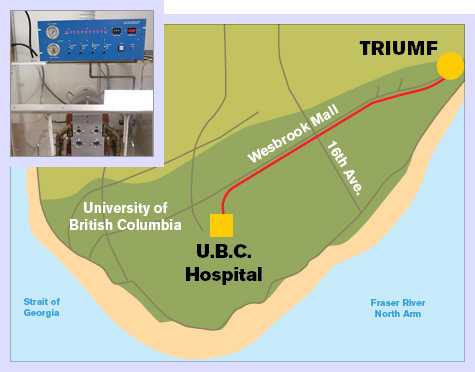 |
| Source: triumf |
Run, Rabbit, run
The problem: How to get short-lived radioactive drugs from the nuclear physics lab that makes them to a hospital 2.5 kilometers away, on the far side of a busy campus, in two minutes flat.
At the University of British Columbia in Vancouver, the solution is the Rabbit—an old-fashioned pneumatic tube that zips freshly made radiopharmaceuticals at 75 kilometers per hour from triumfnational laboratory to the university’s Health Sciences Center.
Pneumatics–using pressurized gas to do work–is a concept dating back to Hero of Alexandria in 60 A.D. Pneumatic tubes were first used in the 1800s to carry mail across European cities; Paris alone had 467 kilometers of tubing in its system. People even envisioned a future in which pneumatic tubes transported people across the globe. The tubes are still used, more modestly, to transport small parcels in banks, hospitals, and office buildings.
triumf’s Rabbit has been making the hop across campus since 1983. As part of a collaboration between the laboratory and the medical center, radioactive isotopes are created in triumf’s cyclotron, which is dedicated to this work, and processed in a chemistry lab on site. Then they’re rushed to the hospital for use in Positron Emission Tomography (PET), a technique that allows doctors to create real-time images of the brain at work.
Why the haste? The radioactive isotopes have half-lives as short as 20 minutes; if a shipment is delayed, the drug will be useless. “It can take quite a long time to meet regulations for the transportation of dangerous goods—to package, carry out the paperwork, and actually get it to the place you want it to go,” says Mike Adam, head of PET Chemistry at triumf.
Although pulling thousands of meters of tubing through existing pipes beneath Wesbrook Mall Road was difficult, and the Rabbit’s route has shifted as the campus grows through construction, the results are worth it, Adam says: “The system is a great advantage in our research on cancer and movement disorders.”
Ken Kingery
Click here to download the pdf version of this article.






